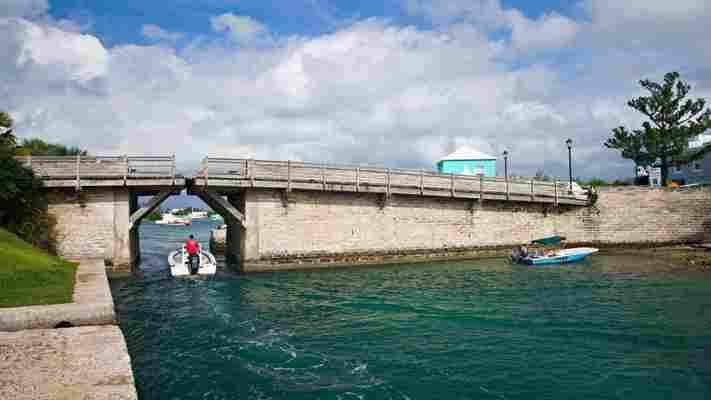Article continues below
It takes an average of two seconds to cross Bermuda’s Somerset Bridge by car – sneeze and you might miss it.
With an opening just 56cm wide, the world's smallest drawbridge is large enough to accommodate the mast of a sailboat. Yet the bridge, which links the southern tip of Somerset Island to Sandys Parish on the south-western shore of the main island, once saved Bermuda’s residents up to three hours in travel time.

Bermuda’s Somerset Bridge is the smallest drawbridge in the world (Credit: Bermuda Tourism)
You may also be interested in: • China’s impossible engineering feat • The world’s most densely populated isle • The temples that had to be moved
“For small Bermuda sloops, the shortest route to the open sea from the central and western parishes of Bermuda was via Somerset Bridge, rather than taking the long channel around the north and east coast of Bermuda,” said Dr Edward Harris, former director of the National Museum of Bermuda .
Today, 10 bridges connect eight islands and Bermuda’s mainland, but four centuries ago, the only way to get from one island to another was by boat. In 1620, The Bermuda General Assembly decided to construct the first three bridges, including Somerset Bridge, to allow residents to gather more easily. At that time, most people living in Bermuda relied on boats for fishing and general transport, but strong south-west winds made navigating Bermuda’s waters challenging. In the early 17th Century, a type of ship known as a sloop – equipped with high, raked masts and triangular sails – was developed to help islanders sail upwind. The sloop’s innovative design eventually evolved into the Bermuda rig, which was used by the British Navy in the 19th Century and for the America’s Cup in the 1930s. It remains a popular sailing vessel to this day.

Somerset Bridge’s 56cm gap is just large enough to accommodate the mast of a sailboat (Credit: Intersection Photos/Alamy)
With towering palm trees and verdant ferns flanking its moss-covered stone walls, Somerset Bridge looks much as it did nearly 400 years ago, save for the four small yellow chains installed to prevent passers-by from falling into the water below. While it is called a drawbridge, Somerset Bridge did not open and close in the traditional way. Having the ability to raise and lower the two sides of the bridge would have required a more complex design, and the waterway was not wide enough for anything larger than a sloop to pass. Instead, builders left a 56cm gap across the centre of the bridge covered by a loose plank of wood.
As sloops approached the bridge, an overseer would raise the wooden plank from the bridge floor to allow the sail to pass through. The overseer would then assist the captain in navigating the sail through the narrow breach, and replace the plank once the sloop was safely past.
Sneeze and you might miss it
Sailing remained the primary form of transportation in Bermuda until the mid-20th Century. But as automobile traffic grew and boat traffic waned, the Bermuda government decided to retire the drawbridge. “The bridge is operational, but it doesn't open because it's an important part of the main road that links the largest and most eastern parish – Sandys Parish to Southampton,” explained Larry Rogers, owner of Rogers Transfers & Island Tours.
But the bridge remains treasured by residents and visitors alike. As one of Bermuda’s top tourist attractions, it was featured on a 2009 series of Bermudian banknotes, and in 2015, was officially designated a historical monument.

Built in 1620, Somerset Bridge was designated a historical monument in 2015 (Credit: MJ Photography/Alamy)
Despite its small size, Somerset Bridge does require some upkeep. “I just finished completing the woodwork on the bridge’s two walkways: the north and south entrances,” said Curtis Charles, a construction and maintenance engineer for the Bermuda Ministry of Public Works, who has been working on the bridge for more than 25 years. “The previous wood was 16 years old, and we needed to replace it as moisture got in between the planks and rotted. This time we made sure to treat the wood, so it will last longer, hopefully around 20 years.”
Charles and his team inspect the bridge once a month; they change the pads underneath the portion of the bridge that cars pass over, and check the wooden planks in the walkway and asphalt. He believes that Somerset Bridge is worth protecting.
“It’s a point of pride,” he said.
Join more than three million BBC Travel fans by liking us on Facebook , or follow us on Twitter and Instagram .
If you liked this story, sign up for the weekly bbc.com features newsletter called "If You Only Read 6 Things This Week". A handpicked selection of stories from BBC Travel, Capital, Culture, Earth and Future, delivered to your inbox every Friday.
Leave a Comment